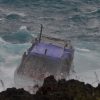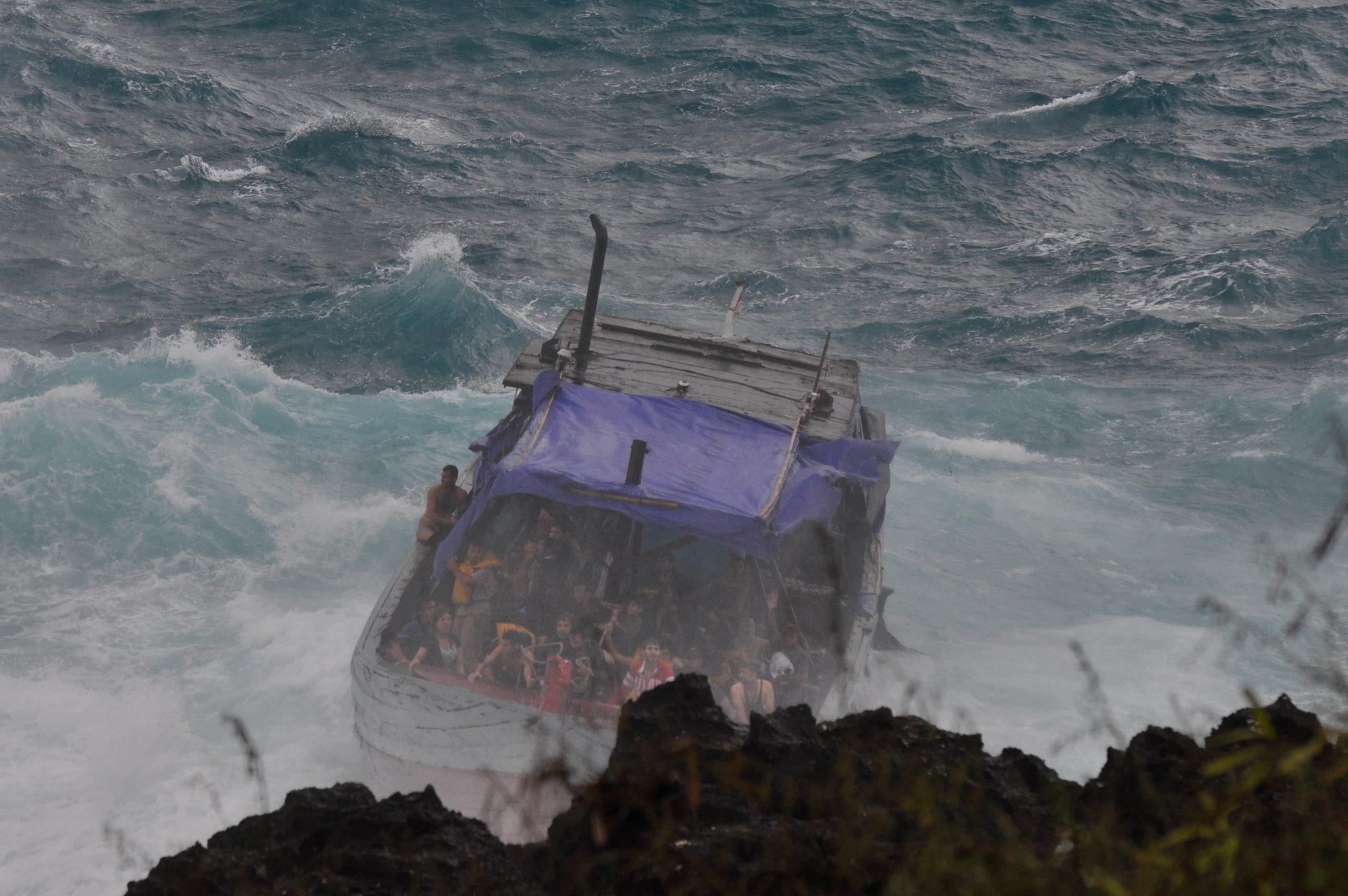
As the day comes to a close, a few of us will look back on of one of Christmas Island’s worst days in living memory. The 15th of December generally passes without much fanfare, and any mention that makes the media is generally for the Lindt Cafe Siege – another headline incident that gripped the country. By daybreak on the 15th of December 2010, an asylum seeker boat was well into the waters surrounding Christmas Island, sealing its fate and that of the 92 people on board.
A day after the incident, I wrote a description of the unfolding of the events……and as I read it back, it took me back to that tragic day. I am sharing some of this with you – in hopes you can understand the overwhelming situation that we found ourselves, a small community in the middle of a big ocean, having to face.
I am forwarding this to people to possibly get a better understanding of what happened. You probably have seen the photos and the footage on the news so I am not presenting anything new, just my take on how it unfolded.
There is also a lot of politicking that is now going to take place in the media and this shouldn’t take anything away from what happened. Regardless of your views on asylum seekers, that morning, these were just people who were victims of an unfortunate chain of events which drew the island residents into a horrifying situation. It may be easy to sit back and state that something should have been done to rescue them, but there just wasn’t anything. If only their motor hadn’t ceased, if only they had continued around to the safer side of the island, if only they had been able to notify the authorities of their position before coming so precariously close to the island……
Plenty of Christmas Islander’s have views on the continual arrival of boats, but everyone who was there just saw people, people who needed help and it came from everywhere as fast as possible. It isn’t until something like this happens that you see the locals, with all their different hats on, who rally quickly and effectively to a situation like this. I commend all those residents who volunteer their weekends and time to training others, checking and maintaining equipment etc. It shows in a situation like this that training and investment in people, actually helps save people.
Criticism will come forward about the Navy and Customs. Why didn’t they know they were there?
As it has been stated, they hadn’t been tracking the boat. Timber craft, in wild seas, are notoriously hard to locate on radar, which is what patrolling aircraft use to try and locate the boats. There is no other technology available that can locate a boat with such surety. Without notification from Indonesia about the boat, or radio contact from other vessels in the area who may have sighted them, it would be like looking for a needle in a haystack, which you aren’t even really sure is there.
Christmas Island has been experiencing almost cyclonic weather conditions on the Northern side of the island for over a week. The Eastern side, which is generally buffeted by wind for 9 months of the year, becomes calm, and provides a safer harbour for launching vessels. This is where the large vessels for Customs and Navy where located. They were in these waters because they actually still had asylum seekers on board from a previous pick up, plus were monitoring another vessel which they had intercepted and towed around to the safe side of the island the day before.
Whilst the Eastern side of the island does have a boat ramp, there is actually no safe facility for landing people ashore. But, the asylum seekers and crew were kept comfortable in calm seas until it was safe to disembark them onto the island. At this location, they have no visual to the Northern face of the island where many of the arrivals take place.
When notified about the stricken vessel, the navy and customs both launched their RHIB’s (4 in total) to get around to the North side of the island as fast as possible. These arrived about 10 minutes before the bigger vessels. At this point the asylum boat was in splinters after hitting the cliff. The folks on these boats rallied quickly, sending a vessel into the debris to pick out the people whilst another vessel hung back a bit to assist the first vessel if they also got into any trouble. This is how wild the seas were, and how close they also had to get to the cliff to get to the people.
We take for granted the education that Australian’s get about the water and the sea. What seems like common sense to us, and what is ingrained into us at a very early age just becomes part of who we are. Watching from the shore it was plain to see that the people on the boat had no such skills, and the people on the shore had no way to communicate what they needed to do.
Their first instinct was to get to shore, so they were all standing at the front of the boat, which weighted the boat heavily to the front. Then when the boat swung side on for a bit, prior to impacting the cliff, they went to the cliff side hoping to jump to shore if the boat swung close enough. When the boat did hit, many of these people ended up in the water as this side of the boat was damaged to the deck and below, and the back quickly started to fill with water.
If they had the understanding that we have about the water, they would have realised it was actually safer to jump onto the ocean side of the vessel at this point, and swim away from the island into still rough, but safer waters.
Some people were getting life vests on, but they continued to stay between the boat and the cliff. There was another sudden big surge of waves and any of those people would have been caught between the cliff and the boat when it hit the second time. I am sure that I saw someone fly through the air at the second impact.
People on the island are still talking about that crack of the timber on the cliff. This is a sound that will stay with many of us for probably most of our lives. The screams and terror of the people were tolerable because it meant they were alive, and afloat, but that ripping of the timber signified the precarious hope we had all been holding that the vessel would stay in one piece, was gone.
It was simply minutes and the vessel was a skeleton with timber and debris, and people in the water. Most of the screaming had stopped and it was just eerie sound of the waves still crashing on the cliff.
Following is the sequence of photos.
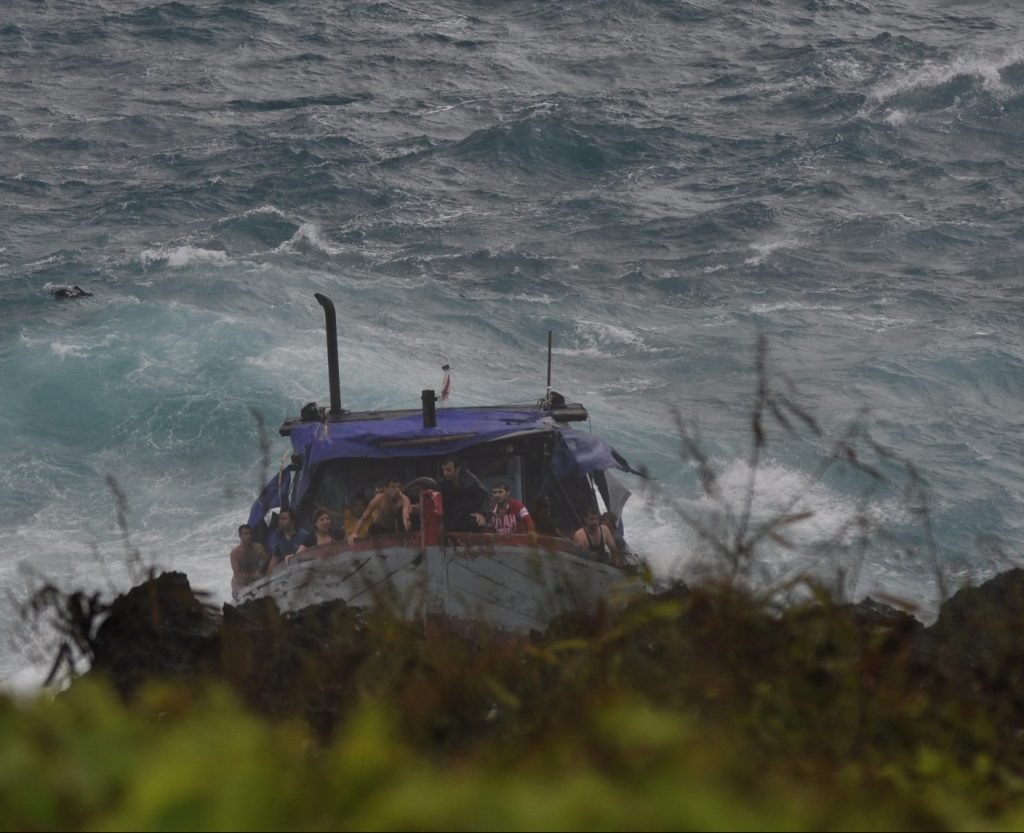
Prior to impact – 92 people on board.
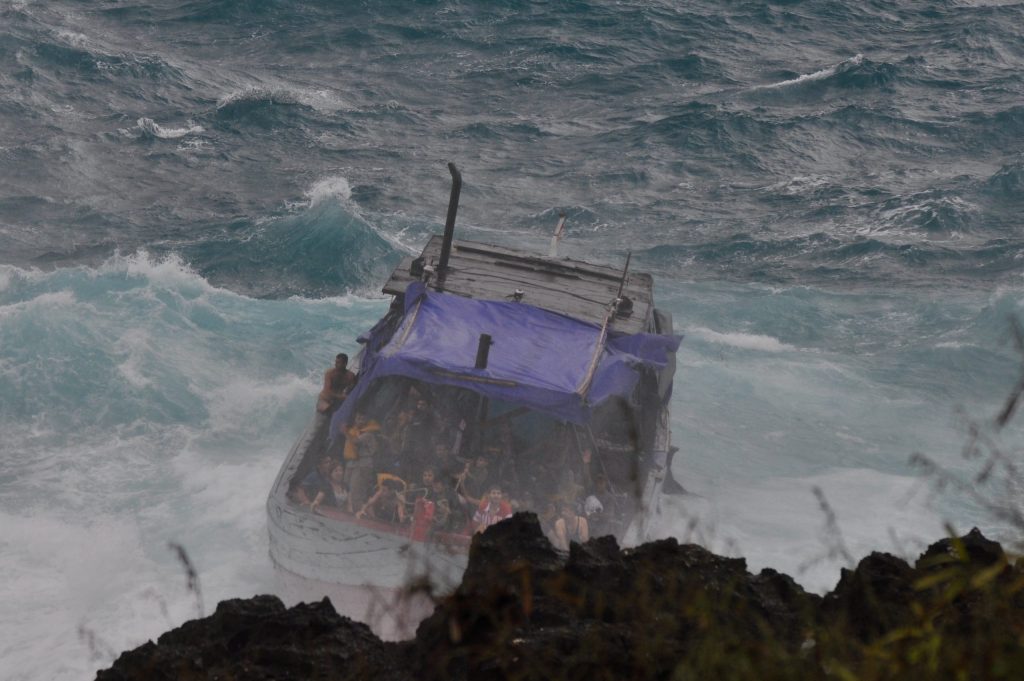
Prior to impact – tossed around in the waves. There were only 11 life jackets on board.
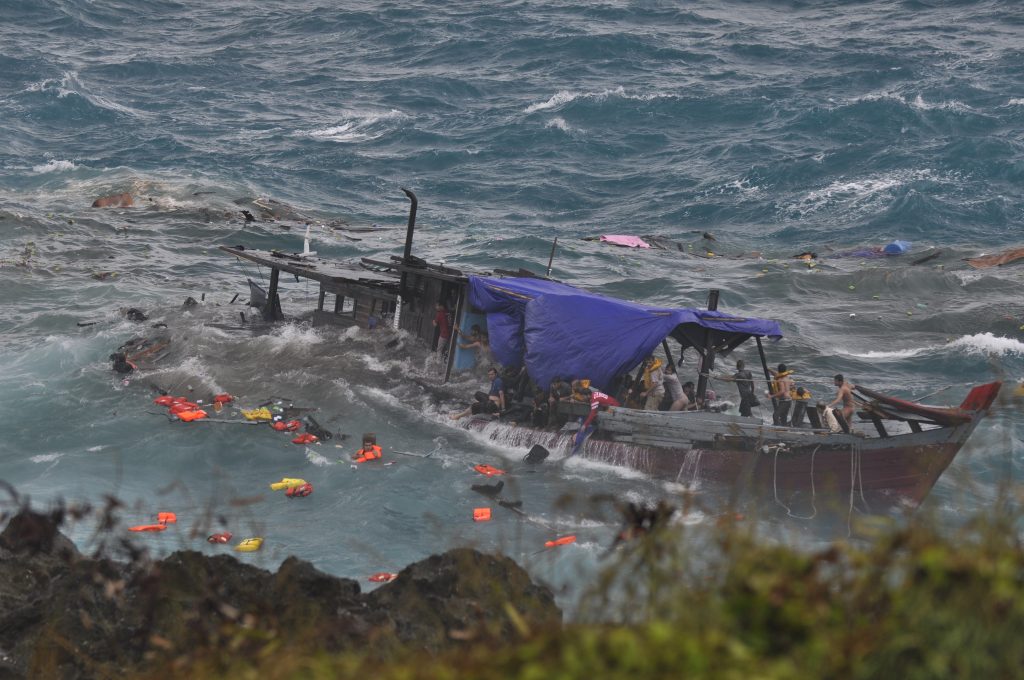
After the first impact. Locals had thrown life jackets in hopes of assisting those who were in the water.
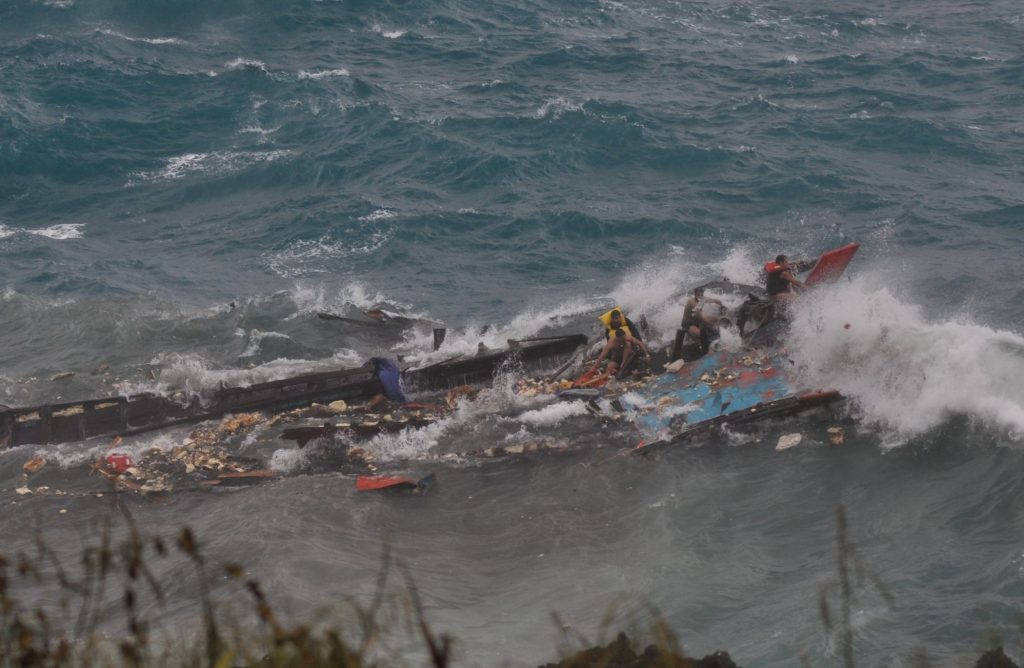
After the second impact with the cliff. 4 people still clinging to the wreck. The man on the bow survived!
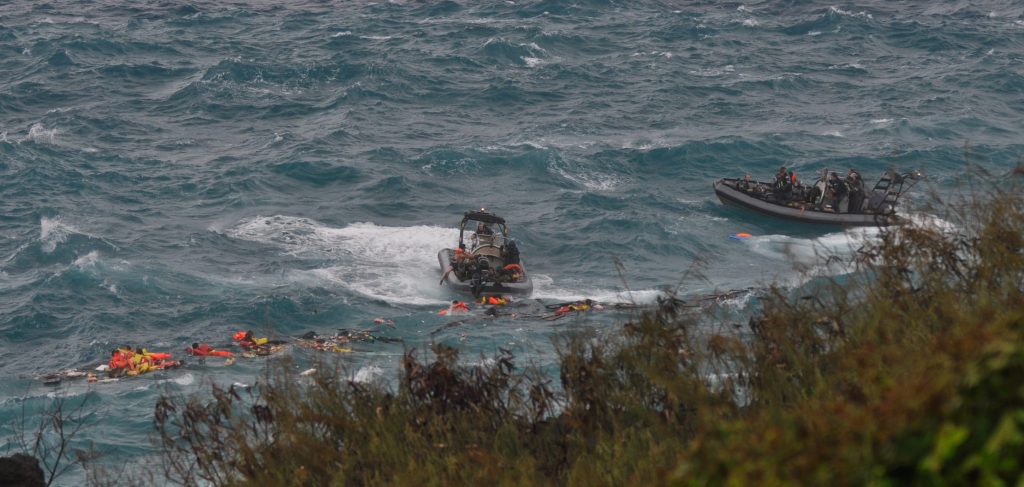
Crews from the ACV Triton and HMAS Pirie commencing the rescue.
Navy and customs rescuing people. They worked very fast but their job was hampered by the debris. They also had reasonably long trips to the larger vessels as they just simply couldn’t be close to the shore with the swell.
Initially the boat was going around to the calmer side of the island. They couldn’t find a landing so turned around apparently, into the cliff to head back around to the Northern side. They were then too close to the cliff and onlookers were trying to tell the crew to get away from the cliff with the boat.
The engine didn’t sound good then and eventually gave up. Where they were pushed into is one of the roughest parts of the cliff face. If they had been 500m further along, they possibly could have beached on the reef and got to shore at Isobel Beach. Another 300m along and they could have beached at the cove. There are also several large moorings near Isobel beach and if they had been able to secure themselves to any of those, they could have waited for the boats to come and pick them up.
The people smugglers who thought it was ok to dispatch this boat to Christmas Island, when they would have been aware of the conditions we had been experiencing, should be charged with wilful murder. Our ocean had been like this for several days, it takes 36-48 hours for a boat to get to the island. They must have been aware.
Many of the islanders are still in shock and the immigration department have provided a counsellor for the first responders and community who feel they need assistance to deal with this. The island is still in mourning and will be for some time.
And how’s this for some irony folks…. It all happened at the end of a small service road that was renamed Tampa View several years ago.




